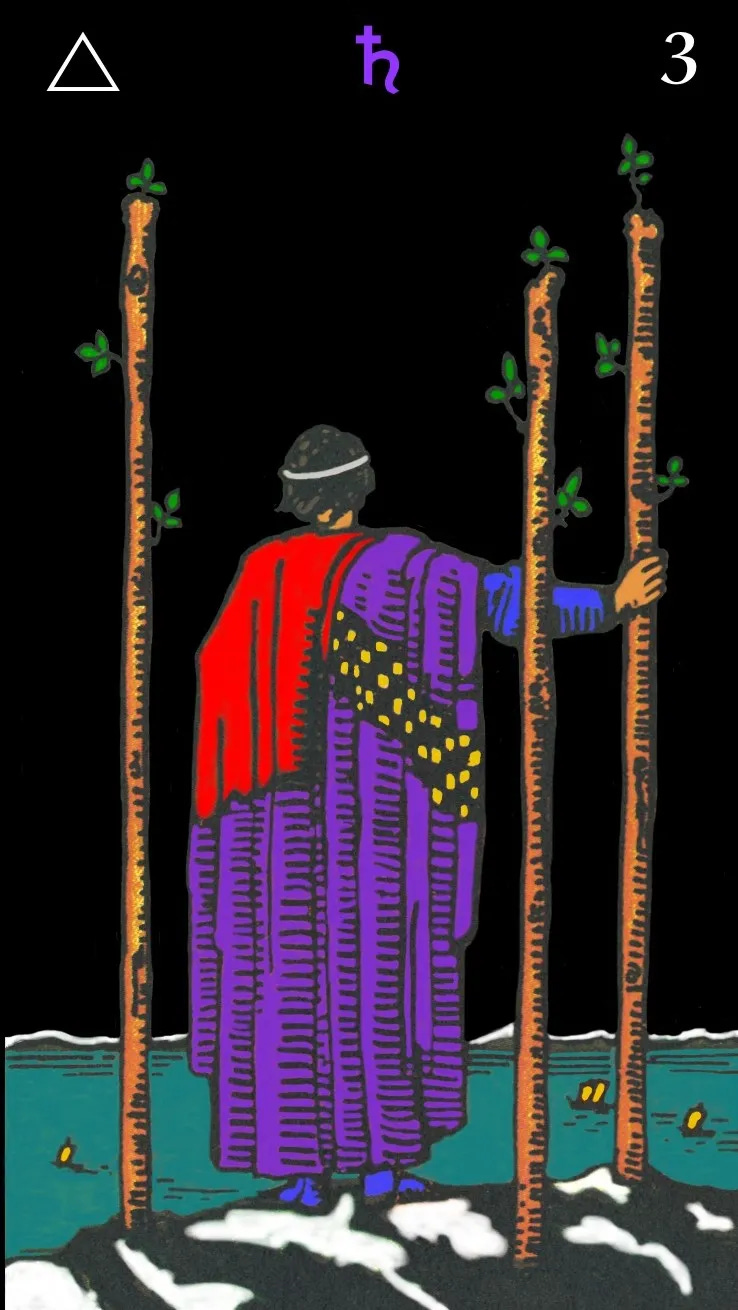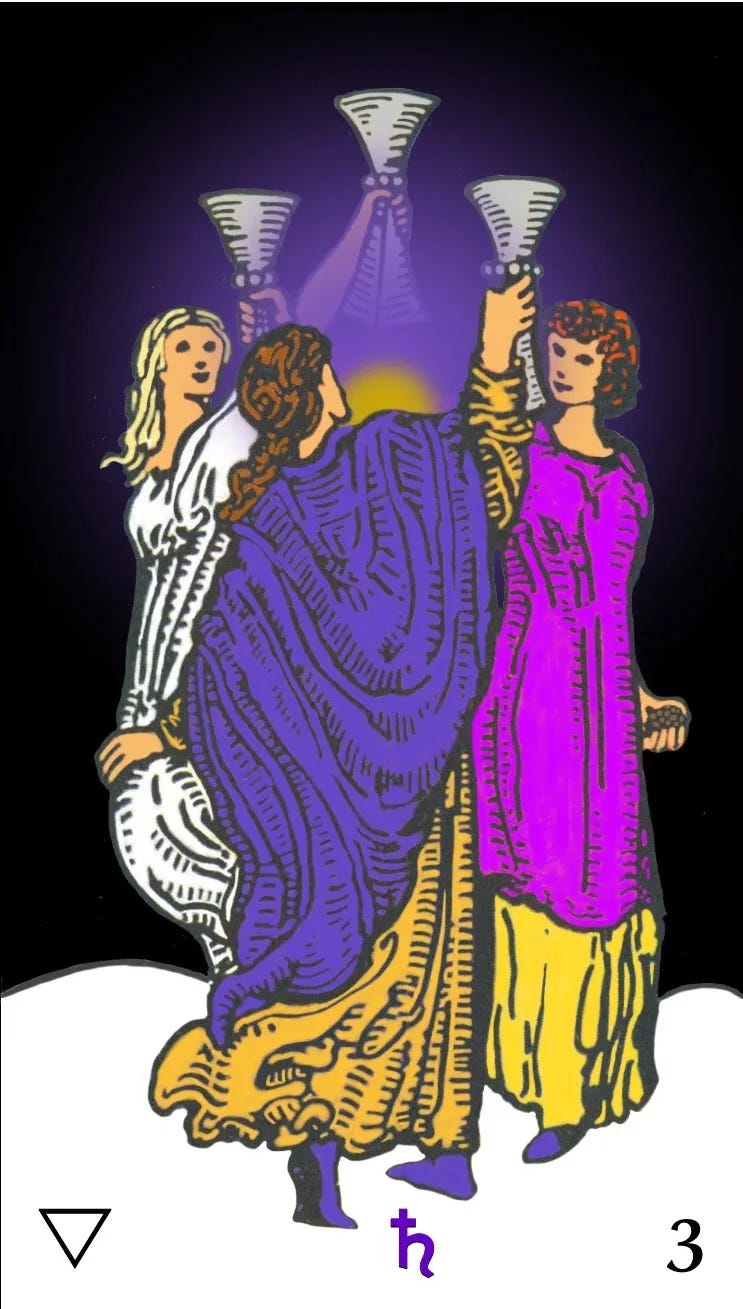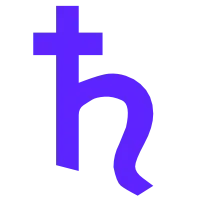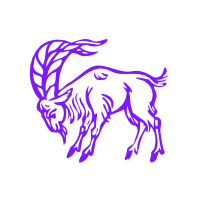A Rainbow of Energies
“What is a god? A god is a personification of a motivating power of a value system that functions in human life and in the universe.”
― Joseph Campbell
The gods have been personified in many ways by the various cultures of the world. Some know these same powers as “archangels” or “planetary spirits”. In Western astrology, we associate them with the planets and call them by the names of Roman gods. But what they are essentially is invisible energies — energies that do things, each with its own frequency and its own type of influence. The most universal and meaningful associations with these life powers that I know of is their correspondences with colors.
"Colors express the main psychic functions of man." ~ Carl Jung
Colors and Astrology
The above illustration shows how the colors fit into astrology. The model is the traditional RYB color wheel used for paint and design. This is the kind of diagram that can yield almost endless insight with continual contemplation over time.
The Circle around the perimeter represents Time. There we see the qualities of Time in colors associated with the 12 signs of the Zodiac.
The hexagon within the Circle represents the life energies from which half of the signs derive their qualities, in terms of color and planet.
The Center of the Circle represents the ultimate Source of All Things in absolute Timelessness. It belongs to no point in Time more or less than any other. The Center’s absoluteness makes White (all of the colors combined) and Black (no color at all) its equivalents in terms of color. They are extreme opposites, yet they are one, like the two sides of a single coin. As planets, these energies are Pluto and Neptune respectively.
The Primary Colors = Fire
The triangle around the Center represents the 3 Primary Colors: Red, Yellow, and Blue, which are fundamental and cannot be created by mixing other colors together. As the spectrum colors ‘closest’ to White, they correspond to the spontaneous motivational impulses of the Fire element, or intuition. If Fire were a section of an orchestra, it would be the brass.
As planets, the Primaries are Mars, the Sun, and Jupiter. The points of the triangle indicate each planet’s rulership (reflected qualities) of the 3 Fire signs in the Zodiac, which share their colors.
The Secondary Colors = Air
A hexagon is formed with the addition of the 3 Secondary Colors, which are blends (‘offspring’) of the Primaries: Orange, Green, and Purple. They correspond to the mental functions of the Air element, or thinking. If Air were a section of an orchestra, it would be the woodwinds.
As planets, the Secondaries are Mercury, Venus, and Uranus. Their points indicate their rulerships of the 3 Air signs in the Zodiac, which share their colors.
In the Zodiac, every other sign is either a Fire sign or an Air sign, sharing the Primary or Secondary Color of its ruling planet, and reflecting its qualities. These 6 signs are the “positive” or “masculine” signs.
The Tertiary Colors = Water & Earth
"Since psyche and matter are contained in one and the same world, and moreover are in continuous contact with one another and ultimately rest on irrepresentable, transcendental factors, it is not only possible but fairly probable, even, that psyche and matter are two different aspects of the same thing." — Carl Jung
The 6 signs in between the masculine ones are the Water (psyche; nonphysical form & feeling) and Earth (matter; physical object & sensation) signs. Theirs are the 6 Tertiary Colors, each a blend of its adjacent neighbors (as though joining with them to form a Circle). If Water were a section of an orchestra, it would be the strings. If Earth were a section of an orchestra, it would be the percussion.
These 6 in-between signs are “negative” or “feminine”, because in them the formless masculine planetary energies take form. Here the term “negative” doesn’t mean inherently “bad”, but refers simply to the impermanent nature of forms.
Forms serve purposes and are neither bad nor good in themselves. But as solid and permanent as many forms seem to be, ultimately none of them really is. Eventually we outgrow, consume, or abandon them, and they dissolve or morph into something else. We can have bad experiences with the feminine signs if we overvalue forms in the mistaken belief that they won’t ever change. Good comes from those bad experiences when we learn from them and get our perspectives better centered.
4 of the feminine signs are ruled by planets in the hexagon whose colors don’t match them, apparently connected with them through their orbit patterns (a different diagram) rather than through color. The other 2 feminine signs are ruled by planets not part of the inner hexagon at all: Saturn and the Moon.
Life ‘Breathes’ Out and In
Life ‘descends’ from the Source into physical manifestation from the Center out, like a blooming flower. Then, as it develops awareness, it ‘ascends’ back to the Central Source.
As human spirits traveling through Time in physical bodies, each of us is continuously developing awareness of all the life energies within. But how can our awareness take us back to the mysterious, ineffable Source?
The color model shows us that we are naturally aligned with the Source when we express all of the ‘colors’ within us clearly and in balance. In the orchestra model, the ‘conductor’ is the Source, and we’re aligned with the ‘Conductor’ when we’re ‘playing all of our instruments’ well and in harmony.
In this series, we’ll take a close look at the planet that rules the sign of the month. We’ll observe its associated color, its legitimate influence in life, and symptoms typically experienced when it’s somehow out of balance. We’ll also see an expression of its basic influence in music and in tarot, as cards of the minor arcana.
Violet
We’re talking here about the Tertiary color Blue-Purple, which is bluer than pure Purple. Violet carries experience, mastery, stability, and authority that Blue doesn’t have, but it lacks the open mind and creativity found in Purple.
Violet is associated with:
Mastery
Stability & Tradition
Authority
Control
Binding to Halt Actions
Fate/Karma
Patience & Persistence
Experience
Maturity
Negative associations include:
Over control
Inertia
Depression



Saturn
Saturn is the mother of all structures, containers, and boundaries. It’s the power that imposes all the limitations, requirements, burdens, and responsibilities of life in the “real” world where we ‘do time’ living out our cyclical stories in physical bodies. Saturn eschews frills and waste, requiring only what is necessary — no less and no more.
The purpose of Saturnine containment is the protection of the weak and undeveloped from challenges with which they are not (yet) equipped to cope. The structures are firm, built up from past experience, authorized for solid, “tried and true” security by Nature or the elders of a society. Examples include (but are not limited to) seed coats, shells, skin, clothing & armor, cribs & playpens, cooking pots, boxes, buildings, walls and fences, families, and established traditions & institutions of all kinds. Saturn’s containing and binding functions are symbolized in circles and rings.
The container has control over, and responsibility for, whatever it contains, which is a burden, welcome or otherwise. The content, dependent on the container for support, has no control or responsibility, but must conform to the requirements of the container that is molding it until it is ready for release. Thus Saturn guards its charge like a parent with a developing baby in a playpen, or a cook stirring ingredients for a period of time as it develops into a meal over the fire.
That’s all natural and good as far as it needs to go. But eventually the growing child outgrows the playpen, and the simmering meal is ready to be served. Sometimes there is dysfunction, and containers squeeze harder instead of letting go, unwilling to relinquish their control and release their contents when they’re supposed to.
Considering the very feminine function of Saturn, I believe it would be better named for his wife, Rhea. As the only planetary power that is truly Earthy, and in keeping with its concerns with time and responsibility, Saturn is associated with a serious, no-nonsense, cold, matriarchal sort of personality that commands (or demands) respect. It’s a power that is not particularly popular, because it often forces us to do what we don’t want to do. Depending on our state of awareness, that may or may not be exactly what we need at any given time. Some restrictions can never be outgrown as long as we live; others should be outgrown eventually, and usually are.
In myth, Saturn frequently appears as a grim and harsh female adversary whose domination is eventually outgrown. For example, in the fairy tale Sleeping Beauty, the Saturnine character is the one fairy who is snubbed and excluded from the party to which all the other planetary spirits fairies are invited to bestow their gifts on the baby princess. Instead of a blessing, she bestows a curse.
In Cinderella, Saturn appears as Ella’s wicked stepmother, who has taken the place of her deceased real mother (aka her fairy godmother, played by Neptune). Via imagination, the fairy godmother supplies to Ella the advantages denied to her by the stepmother.
In these examples, Saturn’s influence is obviously unbalanced and cruel. But then, under the inevitable practical pressures of real life, even the best of earthly mothers don’t compare very well with carefree imaginary mothers. To grow well, we all need both kinds of mother.
In astrology, Saturn indicates duty, delays, difficulties, and/or barriers. Something needs to be done, and it may need to be done the old-fashioned hard way. In some cases Saturn indicates a time for something to be either firmly reinforced or ended. Personal responsibility, patience, and persistence are required.
The composer of the piece below, Gustav Holst, was also a brilliantly insightful astrologer. He composed The Planets, a suite of pieces for each of 7 planets. All of them sound exactly like the planetary influences they express feel. This one is the longest, as appropriate to Saturn’s association with Time. There’s informative text, but the sound is more important. Note the allusions to time (seemingly endless or too short), the bearing of a heavy burden, and the relief of satisfactory achievement at the end.
Saturn, the Bringer of Old Age - Holst


Saturn Rules Capricorn
Capricorn (Violet) is the sign of responsibility and patient persistence.
Read about Capricorn here:
Tarot and the Planets
In tarot, the planets have their correspondences in the cards of the Minor Arcana. Each of the 10 numbers corresponds to a planet. There are 4 cards to a number, one for each of the 4 elements:
Wands = Fire
Swords = Air
Cups = Water
Pentacles = Earth
I’ll give you descriptions of the cards in my deck, along with the interpretations I generally use for them in divination (adapted to context as needed). If you read tarot, the meanings you use may be different from mine, which is fine.
The Threes of the Minor Arcana
The tarot Threes are the Saturn cards, and they all represent definite commitments. No “maybes” here; at this point a choice has been made. It’s fate and on schedule to happen.
Reversed, a Three indicates the end of a commitment, either broken prematurely by one or more parties, or terminated naturally, having fulfilled its purpose.
Three of Wands
A man stands on high ground overlooking the sea. He is watching several ships that are sailing away from him in different directions. They are his ships, bound to carry out his intentions.
Upright - A commitment to do something, an established plan is launched.
Reversed - A plan is cancelled, abandoned, or has been fulfilled.
Three of Swords
Three swords pierce a heart, on which a heavy rain pours down from dark clouds.
Upright - A fateful decision. Because of it, there’s going to be trouble.
Reversed - Expected trouble has been averted and won’t happen after all.
Three of Cups
Three women dance on the snow, each holding a cup aloft. They are dancing in a tight circle around a glowing golden light.
Upright - An ongoing relationship is established, as an ongoing friendship, partnership or marriage.
Reversed - The end of a relationship; divorce.
Three of Pentacles
Three men stand in a stone building that appears to be a church under construction. Two of them are showing plans for the building to a third man, who is carrying out the plans for the required stonework, chisel in hand.
Upright - A contract, sale or business deal with attendant obligations.
Reversed - A broken or expired contract with no further obligations.














